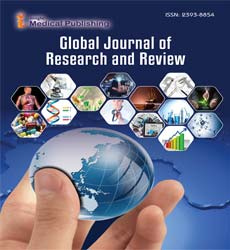ISSN : 2393-8854
Global Journal of Research and Review
Epigenetic Regulation in Development and Disease
Klea Silvan*
Department of Applied Medical Sciences, University of Northern Border, Arar 48956, Saudi Arabia
*Corresponding author:
Klea Silvan,
Department of Applied Medical Sciences, University of Northern Border, Arar 48956, Saudi Arabia,
E-mail: Silvan.kle@gmail.com
Received date: February 03, 2025, Manuscript No. ipgjrr-25-20640; Editor assigned date: February 05, 2025, PreQC No ipgjrr-25-20640(PQ); Reviewed date: February 10, 2025, QC No. ipgjrr-25-20640; Revised date: February 17, 2025, Manuscript No. ipgjrr-25-20640 (R); Published date: February 24, 2025, DOI: 10.36648/2393-8854.12.1.04
Citation: Silvan K (2025) Epigenetic Regulation in Development and Disease. Glob J Res Rev.12.1.04
Introduction
The human genome contains the blueprint for life, yet the instructions encoded within DNA are not sufficient on their own to explain the diversity of cellular functions and the complexity of biological systems. Beyond the genetic code lies an additional layer of control known as epigenetics, which governs how, when and where genes are expressed without altering the underlying DNA sequence. Epigenetic regulation involves chemical modifications to DNA and histone proteins, as well as non-coding RNAs, that collectively determine gene activity. This dynamic regulatory system is fundamental to development, as it allows a single fertilized egg to give rise to the multitude of specialized cells that make up the human body. At the same time, disruptions in epigenetic mechanisms are increasingly recognized as drivers of various diseases, including cancer, neurodevelopmental disorders, autoimmune conditions and metabolic syndromes. The study of epigenetics has therefore emerged as a critical field that bridges genetics, environment and health, providing insights into both normal biological processes and pathological states [1].
Description
Epigenetic regulation refers to heritable yet reversible modifications that influence gene expression without changing the DNA sequence itself. The primary mechanisms include DNA methylation, histone modifications, chromatin remodeling and non-coding RNAs. Together, these systems orchestrate the activation and silencing of genes in a context-dependent manner, shaping cellular identity and function throughout development and in response to environmental cues. DNA methylation is one of the best-studied epigenetic modifications.
It typically involves the addition of a methyl group to cytosine residues within CpG dinucleotides, often leading to gene silencing. During embryonic development, waves of DNA methylation and demethylation establish lineage-specific gene expression patterns, ensuring that pluripotent stem cells differentiate into diverse cell types. Abnormal DNA methylation is a hallmark of many diseases. For example, hypermethylation of tumor suppressor genes contributes to carcinogenesis, while global hypomethylation can lead to genomic instability. In neurological disorders such as Rett syndrome, mutations affecting methyl-CpG-binding proteins disrupt normal epigenetic signaling, resulting in profound developmental impairments [2].
Histone modifications represent another major mechanism of epigenetic regulation. DNA is packaged around histone proteins to form chromatin and the chemical modification of histone tails through processes such as acetylation, methylation, phosphorylation and ubiquitination alters chromatin structure and accessibility. Acetylation generally promotes gene activation by loosening chromatin, while certain methylation marks may either activate or repress transcription depending on their location. During development, histone modifications help establish enhancer landscapes that drive tissue-specific gene expression.
Dysregulation of histone-modifying enzymes has been linked to cancers, inflammatory conditions and developmental disorders. For instance, mutations in histone methyltransferases or demethylases can alter gene expression programs, fueling oncogenesis or impairing differentiation [1]. Chromatin remodeling further contributes to epigenetic control by repositioning nucleosomes along DNA, thereby regulating access to transcriptional machinery. ATP-dependent chromatin remodelers play essential roles in processes such as embryogenesis and organ formation.
Mutations in chromatin remodeling complexes, such as those seen in Coffinâ??Siris syndrome or certain pediatric cancers, highlight their importance in both development and disease. Non-coding RNAs, including MicroRNAs (miRNAs) and Long Non-Coding RNAs (lncRNAs), provide yet another layer of epigenetic regulation. These molecules can modulate gene expression post-transcriptionally or recruit chromatin modifiers to specific genomic loci. In development, non-coding RNAs help fine-tune gene networks that guide differentiation and tissue morphogenesis. In disease contexts, aberrant expression of miRNAs has been associated with tumor progression, immune dysregulation and metabolic imbalance. For example, oncogenic miRNAs can silence tumor suppressor pathways, while loss of tumor-suppressive miRNAs contributes to unchecked proliferation [2].
Conclusion
Epigenetic regulation serves as a fundamental mechanism linking genetic information with cellular identity, environmental influences and disease outcomes. By orchestrating complex gene expression programs, epigenetic modifications drive normal development and ensure the diversity of cellular functions in multicellular organisms. When disrupted, these same mechanisms can contribute to a broad spectrum of diseases, ranging from cancer and neurodevelopmental disorders to autoimmune and metabolic conditions. The reversibility of epigenetic changes makes them particularly compelling as therapeutic targets, while their role as biomarkers enhances diagnostic precision.
As research continues to unravel the intricacies of the epigenome, the boundaries between genetics, environment and health are becoming increasingly interconnected. Ultimately, the study of epigenetic regulation not only deepens our understanding of development and disease but also paves the way for innovative approaches in diagnosis, prevention and treatment, marking it as one of the most promising fields in modern biomedical science.
Acknowledgement
None.
Conflict of Interest
None.
References
- Neta P, Maruthamuthu P, Carton PM, Fessenden RW (1978) Formation and reactivity of the amino radical. J Phys Chem 82: 1875-1878.
- Abdullah M, Low GKC, Matthews RW (1990) Effects of common inorganic anions on rates of photocatalytic oxidation of organic carbon over illuminated titanium dioxide. J Phys Chem 94(17): 6820-6825.
Open Access Journals
- Aquaculture & Veterinary Science
- Chemistry & Chemical Sciences
- Clinical Sciences
- Engineering
- General Science
- Genetics & Molecular Biology
- Health Care & Nursing
- Immunology & Microbiology
- Materials Science
- Mathematics & Physics
- Medical Sciences
- Neurology & Psychiatry
- Oncology & Cancer Science
- Pharmaceutical Sciences
